Organization Behavior Report on Leadership and Decision Making
VerifiedAdded on 2019/12/03
|13
|3855
|197
Report
AI Summary
This report delves into the multifaceted realm of organizational behavior, examining key aspects such as leadership theories, managerial styles, and their impact on corporate effectiveness. It explores various leadership approaches, including contingency and behavioral theories, and analyzes the influence of managerial styles like autocratic, democratic, and laissez-faire on employee motivation and organizational outcomes. The report further investigates motivational theories, like cognitive, reinforcement, and equity theories, and their application in enhancing employee engagement. It also describes work relationships, interaction theories, and the organizational structure and culture of Google, along with the decision-making process within ASDA, covering rational, behavioral, and practical approaches, and management strategies for risk and uncertainty. The report concludes with an overview of how these elements interplay to shape organizational success.
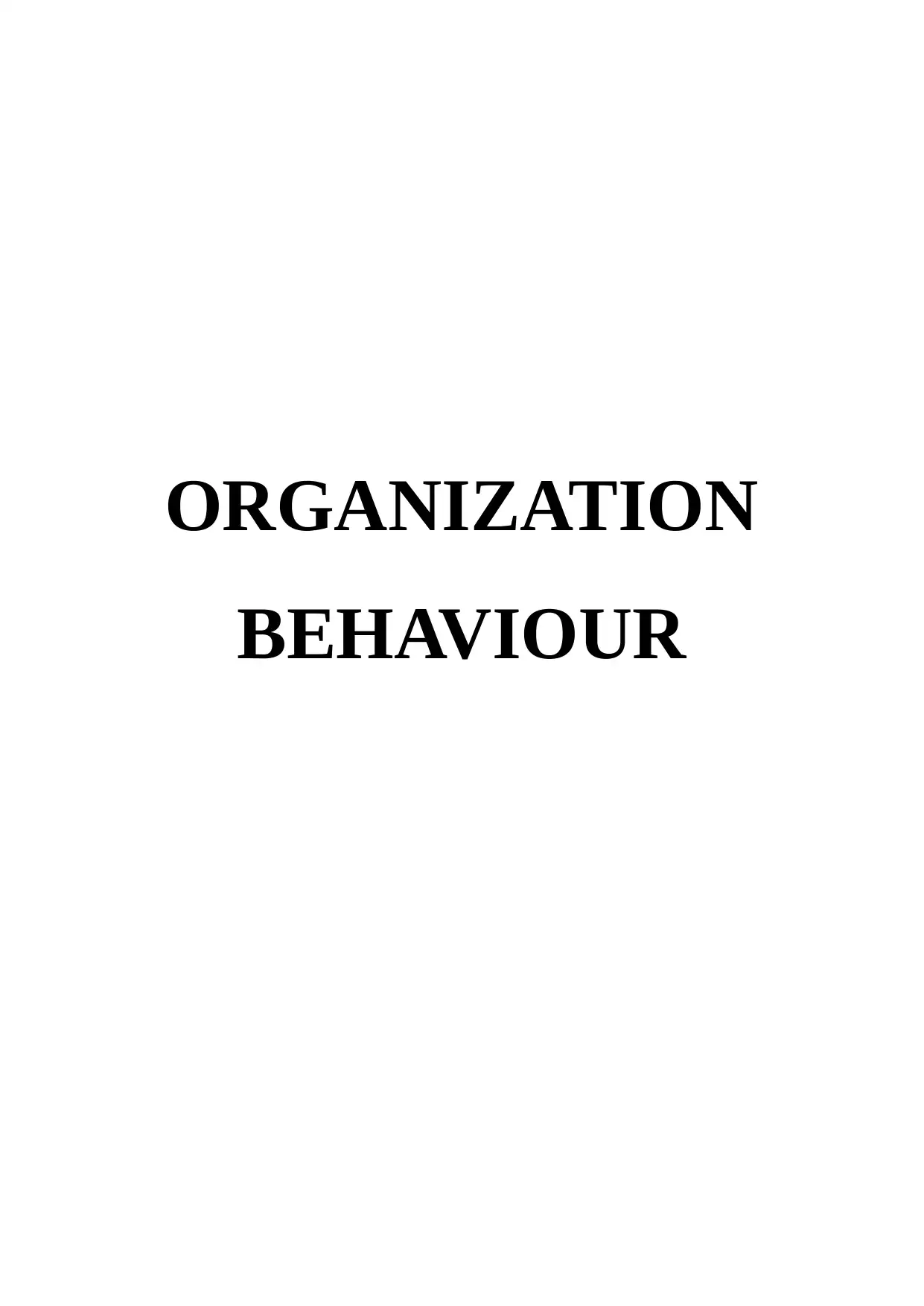
ORGANIZATION
BEHAVIOUR
BEHAVIOUR
Paraphrase This Document
Need a fresh take? Get an instant paraphrase of this document with our AI Paraphraser
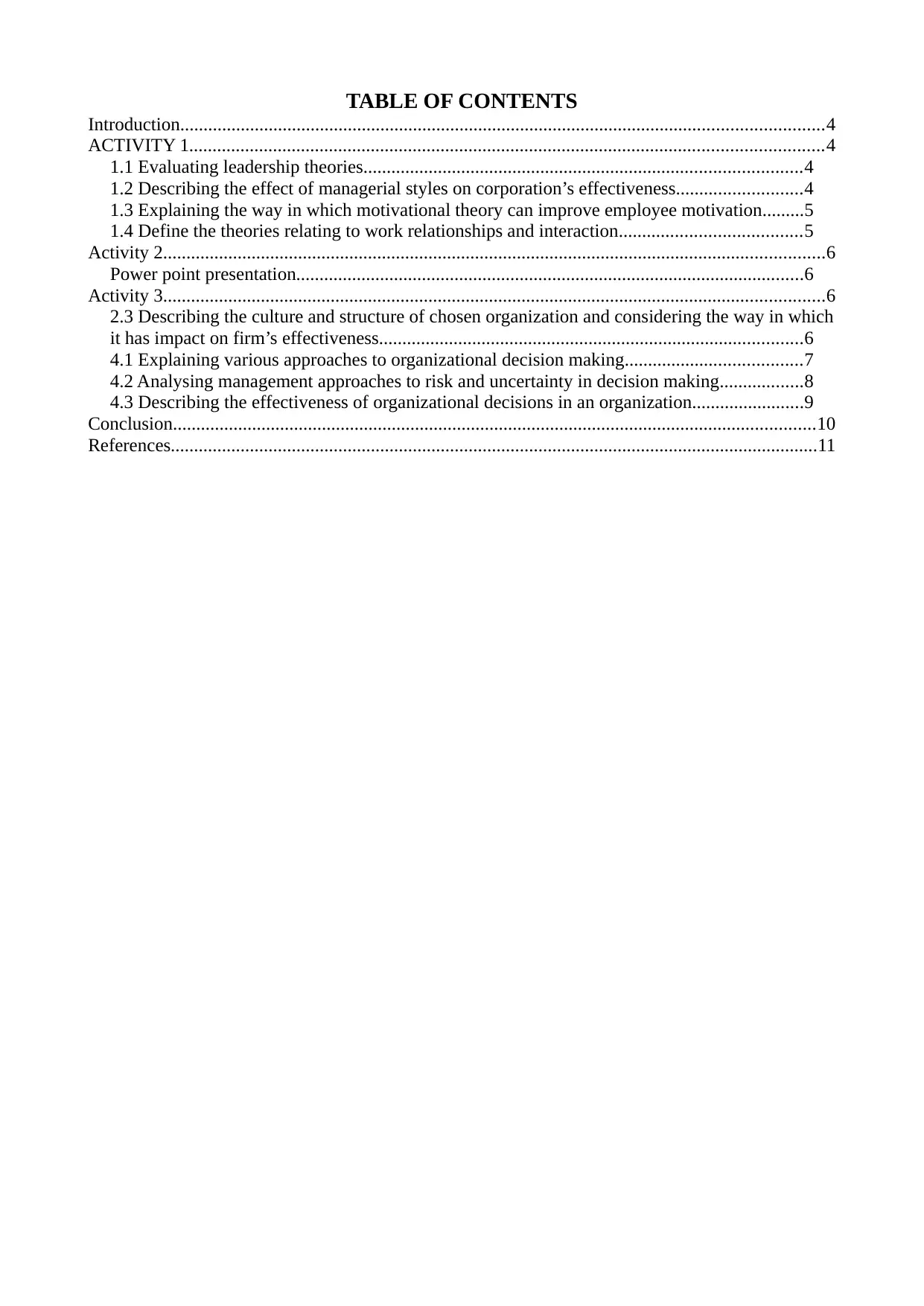
TABLE OF CONTENTS
Introduction..........................................................................................................................................4
ACTIVITY 1........................................................................................................................................4
1.1 Evaluating leadership theories..............................................................................................4
1.2 Describing the effect of managerial styles on corporation’s effectiveness...........................4
1.3 Explaining the way in which motivational theory can improve employee motivation.........5
1.4 Define the theories relating to work relationships and interaction.......................................5
Activity 2..............................................................................................................................................6
Power point presentation.............................................................................................................6
Activity 3..............................................................................................................................................6
2.3 Describing the culture and structure of chosen organization and considering the way in which
it has impact on firm’s effectiveness...........................................................................................6
4.1 Explaining various approaches to organizational decision making......................................7
4.2 Analysing management approaches to risk and uncertainty in decision making..................8
4.3 Describing the effectiveness of organizational decisions in an organization........................9
Conclusion..........................................................................................................................................10
References...........................................................................................................................................11
Introduction..........................................................................................................................................4
ACTIVITY 1........................................................................................................................................4
1.1 Evaluating leadership theories..............................................................................................4
1.2 Describing the effect of managerial styles on corporation’s effectiveness...........................4
1.3 Explaining the way in which motivational theory can improve employee motivation.........5
1.4 Define the theories relating to work relationships and interaction.......................................5
Activity 2..............................................................................................................................................6
Power point presentation.............................................................................................................6
Activity 3..............................................................................................................................................6
2.3 Describing the culture and structure of chosen organization and considering the way in which
it has impact on firm’s effectiveness...........................................................................................6
4.1 Explaining various approaches to organizational decision making......................................7
4.2 Analysing management approaches to risk and uncertainty in decision making..................8
4.3 Describing the effectiveness of organizational decisions in an organization........................9
Conclusion..........................................................................................................................................10
References...........................................................................................................................................11
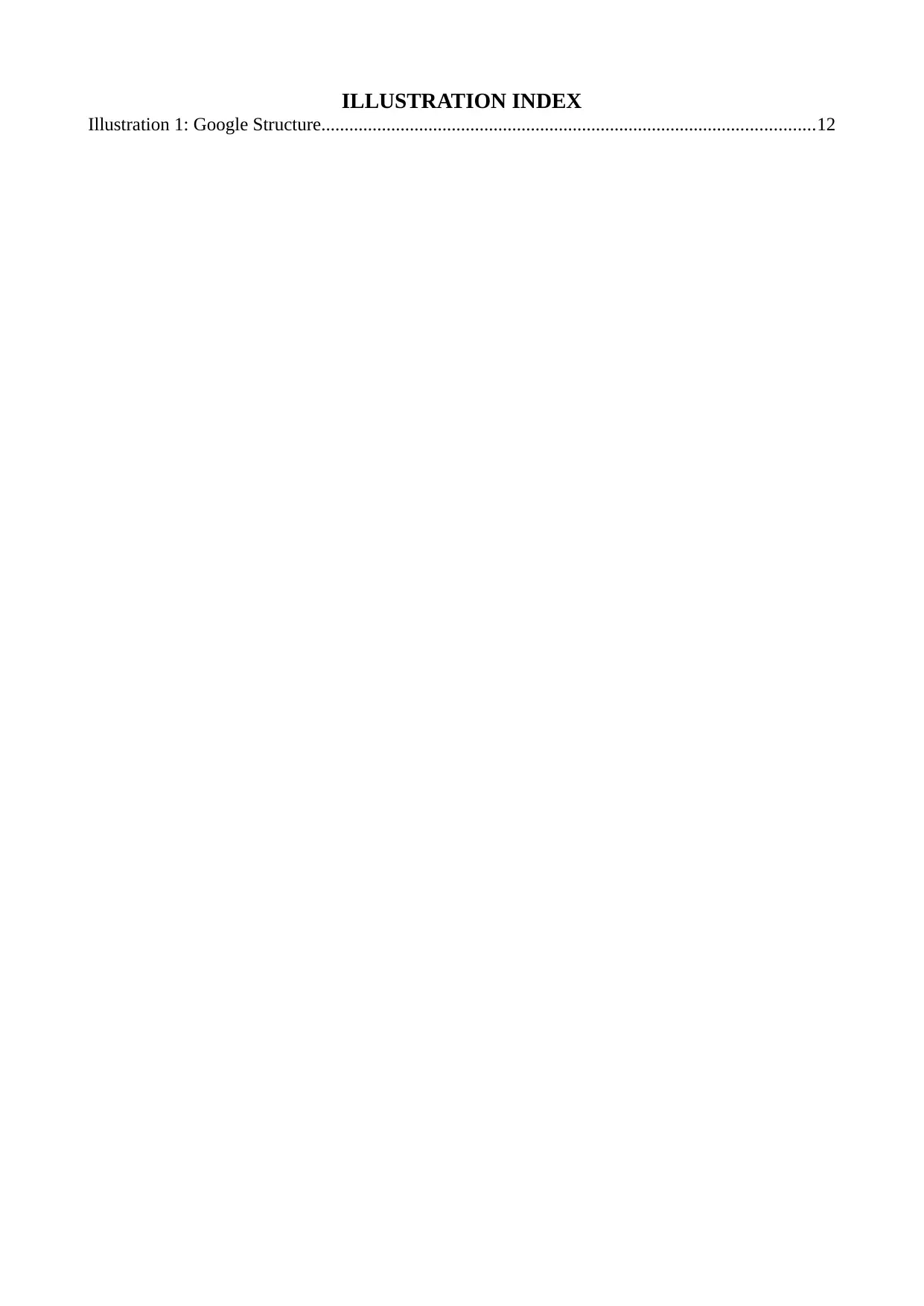
ILLUSTRATION INDEX
Illustration 1: Google Structure..........................................................................................................12
Illustration 1: Google Structure..........................................................................................................12
⊘ This is a preview!⊘
Do you want full access?
Subscribe today to unlock all pages.

Trusted by 1+ million students worldwide

Paraphrase This Document
Need a fresh take? Get an instant paraphrase of this document with our AI Paraphraser
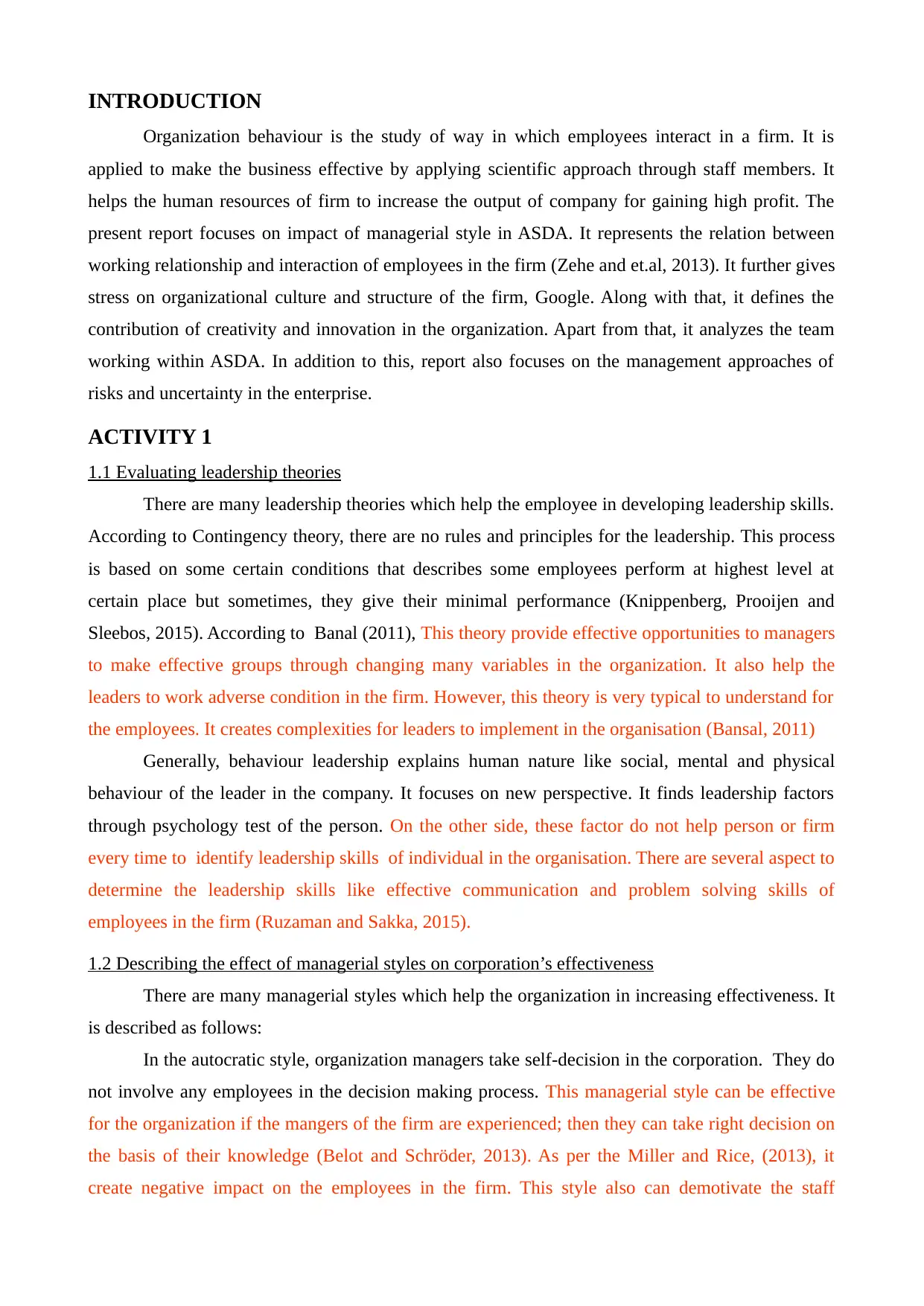
INTRODUCTION
Organization behaviour is the study of way in which employees interact in a firm. It is
applied to make the business effective by applying scientific approach through staff members. It
helps the human resources of firm to increase the output of company for gaining high profit. The
present report focuses on impact of managerial style in ASDA. It represents the relation between
working relationship and interaction of employees in the firm (Zehe and et.al, 2013). It further gives
stress on organizational culture and structure of the firm, Google. Along with that, it defines the
contribution of creativity and innovation in the organization. Apart from that, it analyzes the team
working within ASDA. In addition to this, report also focuses on the management approaches of
risks and uncertainty in the enterprise.
ACTIVITY 1
1.1 Evaluating leadership theories
There are many leadership theories which help the employee in developing leadership skills.
According to Contingency theory, there are no rules and principles for the leadership. This process
is based on some certain conditions that describes some employees perform at highest level at
certain place but sometimes, they give their minimal performance (Knippenberg, Prooijen and
Sleebos, 2015). According to Banal (2011), This theory provide effective opportunities to managers
to make effective groups through changing many variables in the organization. It also help the
leaders to work adverse condition in the firm. However, this theory is very typical to understand for
the employees. It creates complexities for leaders to implement in the organisation (Bansal, 2011)
Generally, behaviour leadership explains human nature like social, mental and physical
behaviour of the leader in the company. It focuses on new perspective. It finds leadership factors
through psychology test of the person. On the other side, these factor do not help person or firm
every time to identify leadership skills of individual in the organisation. There are several aspect to
determine the leadership skills like effective communication and problem solving skills of
employees in the firm (Ruzaman and Sakka, 2015).
1.2 Describing the effect of managerial styles on corporation’s effectiveness
There are many managerial styles which help the organization in increasing effectiveness. It
is described as follows:
In the autocratic style, organization managers take self-decision in the corporation. They do
not involve any employees in the decision making process. This managerial style can be effective
for the organization if the mangers of the firm are experienced; then they can take right decision on
the basis of their knowledge (Belot and Schröder, 2013). As per the Miller and Rice, (2013), it
create negative impact on the employees in the firm. This style also can demotivate the staff
Organization behaviour is the study of way in which employees interact in a firm. It is
applied to make the business effective by applying scientific approach through staff members. It
helps the human resources of firm to increase the output of company for gaining high profit. The
present report focuses on impact of managerial style in ASDA. It represents the relation between
working relationship and interaction of employees in the firm (Zehe and et.al, 2013). It further gives
stress on organizational culture and structure of the firm, Google. Along with that, it defines the
contribution of creativity and innovation in the organization. Apart from that, it analyzes the team
working within ASDA. In addition to this, report also focuses on the management approaches of
risks and uncertainty in the enterprise.
ACTIVITY 1
1.1 Evaluating leadership theories
There are many leadership theories which help the employee in developing leadership skills.
According to Contingency theory, there are no rules and principles for the leadership. This process
is based on some certain conditions that describes some employees perform at highest level at
certain place but sometimes, they give their minimal performance (Knippenberg, Prooijen and
Sleebos, 2015). According to Banal (2011), This theory provide effective opportunities to managers
to make effective groups through changing many variables in the organization. It also help the
leaders to work adverse condition in the firm. However, this theory is very typical to understand for
the employees. It creates complexities for leaders to implement in the organisation (Bansal, 2011)
Generally, behaviour leadership explains human nature like social, mental and physical
behaviour of the leader in the company. It focuses on new perspective. It finds leadership factors
through psychology test of the person. On the other side, these factor do not help person or firm
every time to identify leadership skills of individual in the organisation. There are several aspect to
determine the leadership skills like effective communication and problem solving skills of
employees in the firm (Ruzaman and Sakka, 2015).
1.2 Describing the effect of managerial styles on corporation’s effectiveness
There are many managerial styles which help the organization in increasing effectiveness. It
is described as follows:
In the autocratic style, organization managers take self-decision in the corporation. They do
not involve any employees in the decision making process. This managerial style can be effective
for the organization if the mangers of the firm are experienced; then they can take right decision on
the basis of their knowledge (Belot and Schröder, 2013). As per the Miller and Rice, (2013), it
create negative impact on the employees in the firm. This style also can demotivate the staff
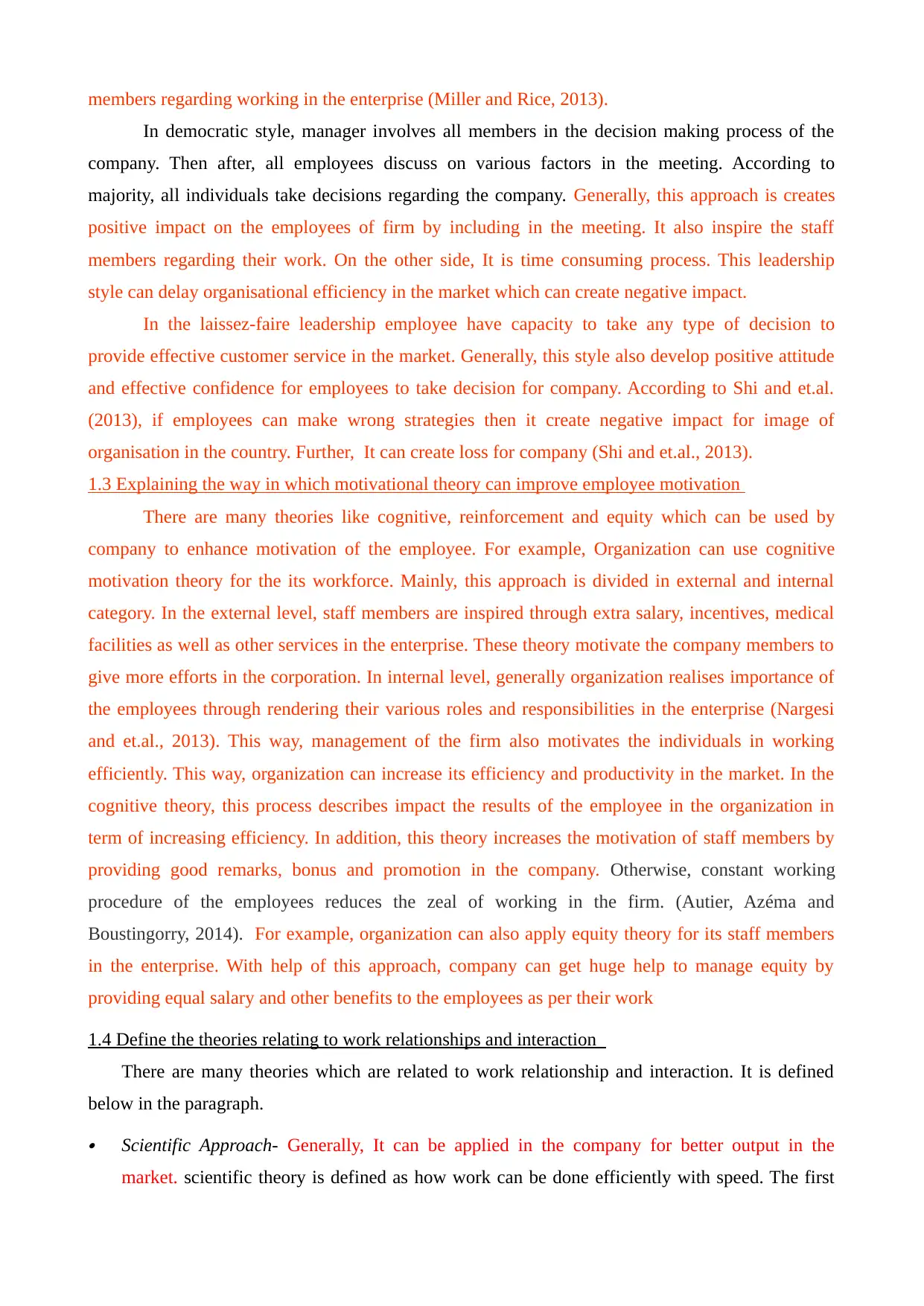
members regarding working in the enterprise (Miller and Rice, 2013).
In democratic style, manager involves all members in the decision making process of the
company. Then after, all employees discuss on various factors in the meeting. According to
majority, all individuals take decisions regarding the company. Generally, this approach is creates
positive impact on the employees of firm by including in the meeting. It also inspire the staff
members regarding their work. On the other side, It is time consuming process. This leadership
style can delay organisational efficiency in the market which can create negative impact.
In the laissez-faire leadership employee have capacity to take any type of decision to
provide effective customer service in the market. Generally, this style also develop positive attitude
and effective confidence for employees to take decision for company. According to Shi and et.al.
(2013), if employees can make wrong strategies then it create negative impact for image of
organisation in the country. Further, It can create loss for company (Shi and et.al., 2013).
1.3 Explaining the way in which motivational theory can improve employee motivation
There are many theories like cognitive, reinforcement and equity which can be used by
company to enhance motivation of the employee. For example, Organization can use cognitive
motivation theory for the its workforce. Mainly, this approach is divided in external and internal
category. In the external level, staff members are inspired through extra salary, incentives, medical
facilities as well as other services in the enterprise. These theory motivate the company members to
give more efforts in the corporation. In internal level, generally organization realises importance of
the employees through rendering their various roles and responsibilities in the enterprise (Nargesi
and et.al., 2013). This way, management of the firm also motivates the individuals in working
efficiently. This way, organization can increase its efficiency and productivity in the market. In the
cognitive theory, this process describes impact the results of the employee in the organization in
term of increasing efficiency. In addition, this theory increases the motivation of staff members by
providing good remarks, bonus and promotion in the company. Otherwise, constant working
procedure of the employees reduces the zeal of working in the firm. (Autier, Azéma and
Boustingorry, 2014). For example, organization can also apply equity theory for its staff members
in the enterprise. With help of this approach, company can get huge help to manage equity by
providing equal salary and other benefits to the employees as per their work
1.4 Define the theories relating to work relationships and interaction
There are many theories which are related to work relationship and interaction. It is defined
below in the paragraph.
Scientific Approach- Generally, It can be applied in the company for better output in the
market. scientific theory is defined as how work can be done efficiently with speed. The first
In democratic style, manager involves all members in the decision making process of the
company. Then after, all employees discuss on various factors in the meeting. According to
majority, all individuals take decisions regarding the company. Generally, this approach is creates
positive impact on the employees of firm by including in the meeting. It also inspire the staff
members regarding their work. On the other side, It is time consuming process. This leadership
style can delay organisational efficiency in the market which can create negative impact.
In the laissez-faire leadership employee have capacity to take any type of decision to
provide effective customer service in the market. Generally, this style also develop positive attitude
and effective confidence for employees to take decision for company. According to Shi and et.al.
(2013), if employees can make wrong strategies then it create negative impact for image of
organisation in the country. Further, It can create loss for company (Shi and et.al., 2013).
1.3 Explaining the way in which motivational theory can improve employee motivation
There are many theories like cognitive, reinforcement and equity which can be used by
company to enhance motivation of the employee. For example, Organization can use cognitive
motivation theory for the its workforce. Mainly, this approach is divided in external and internal
category. In the external level, staff members are inspired through extra salary, incentives, medical
facilities as well as other services in the enterprise. These theory motivate the company members to
give more efforts in the corporation. In internal level, generally organization realises importance of
the employees through rendering their various roles and responsibilities in the enterprise (Nargesi
and et.al., 2013). This way, management of the firm also motivates the individuals in working
efficiently. This way, organization can increase its efficiency and productivity in the market. In the
cognitive theory, this process describes impact the results of the employee in the organization in
term of increasing efficiency. In addition, this theory increases the motivation of staff members by
providing good remarks, bonus and promotion in the company. Otherwise, constant working
procedure of the employees reduces the zeal of working in the firm. (Autier, Azéma and
Boustingorry, 2014). For example, organization can also apply equity theory for its staff members
in the enterprise. With help of this approach, company can get huge help to manage equity by
providing equal salary and other benefits to the employees as per their work
1.4 Define the theories relating to work relationships and interaction
There are many theories which are related to work relationship and interaction. It is defined
below in the paragraph.
Scientific Approach- Generally, It can be applied in the company for better output in the
market. scientific theory is defined as how work can be done efficiently with speed. The first
⊘ This is a preview!⊘
Do you want full access?
Subscribe today to unlock all pages.

Trusted by 1+ million students worldwide

step of this concept is to identify objective of the organization. Then after, management of the
organization designs performance standards to remove the traditional method. Employee does
their job according to expertise and knowledge which help to relate their work relationship and
interaction in the organization. Scientific approach determines the efficiency of company
through time and motion studies (Ruzaman and Sakka, 2015). In addition, firm designs
optimistic working method for employees as per their need at the workplace. Further, the
organization trains its staff members according to new process. This process increases work
relationship and interaction between employees.
Decision making approach- It can be implementation in the company for selecting one
appropriate decision from many alternatives in the given options within the corporation. This
process also relates work relationships and interaction of employees. Generally due to some
restrictions, decision makers formulate plan after discussing in the meeting. Sometimes, they
take their decisions in attaining minimum criteria rather than getting optimal solution due to
lack of alternatives (Blomme and Bornebroek-Te Lintelo, 2012). This type of decision making
approach also connect work relationship and interaction of staff members in the organisation.
ACTIVITY 2
Power point presentation
ACTIVITY 3
2.3 Describing the culture and structure of chosen organization and considering the way in which it
has impact on firm’s effectiveness
Google uses hierarchical structure and basketball culture in the organization. In the
basketball culture, corporation gives freedom to its employees. Staff of the company directly shares
their ideas with the management. Management of organization involves maximum individual in the
decision making process (Coghlan and Brannick, 2014). Culture of Google organization provides
authority to do what they want in the organization. In the firm, there are many effectiveness of
basketball culture. This effective culture helps the company to hire best technical person which are
good in every field like analytical and creativity, thinking process and core field. This culture
improves the practices of the human resource in the Google firm. Further, this department uses
various types of scientific approaches to identify employee behaviour. For example, they use
retention algorithm to find out how many employees are leaving the company in year on basis of
their software report. Basketball culture provides casual and dramatic values in the organization
(Piaget, 2013). Enterprise uses many techniques to entertain through sports, gaming and
management activities. This process explains the mission and vision values of Google organization.
It also states why organization does, what is purpose of firm behind this step (Ropo and et.al.,
organization designs performance standards to remove the traditional method. Employee does
their job according to expertise and knowledge which help to relate their work relationship and
interaction in the organization. Scientific approach determines the efficiency of company
through time and motion studies (Ruzaman and Sakka, 2015). In addition, firm designs
optimistic working method for employees as per their need at the workplace. Further, the
organization trains its staff members according to new process. This process increases work
relationship and interaction between employees.
Decision making approach- It can be implementation in the company for selecting one
appropriate decision from many alternatives in the given options within the corporation. This
process also relates work relationships and interaction of employees. Generally due to some
restrictions, decision makers formulate plan after discussing in the meeting. Sometimes, they
take their decisions in attaining minimum criteria rather than getting optimal solution due to
lack of alternatives (Blomme and Bornebroek-Te Lintelo, 2012). This type of decision making
approach also connect work relationship and interaction of staff members in the organisation.
ACTIVITY 2
Power point presentation
ACTIVITY 3
2.3 Describing the culture and structure of chosen organization and considering the way in which it
has impact on firm’s effectiveness
Google uses hierarchical structure and basketball culture in the organization. In the
basketball culture, corporation gives freedom to its employees. Staff of the company directly shares
their ideas with the management. Management of organization involves maximum individual in the
decision making process (Coghlan and Brannick, 2014). Culture of Google organization provides
authority to do what they want in the organization. In the firm, there are many effectiveness of
basketball culture. This effective culture helps the company to hire best technical person which are
good in every field like analytical and creativity, thinking process and core field. This culture
improves the practices of the human resource in the Google firm. Further, this department uses
various types of scientific approaches to identify employee behaviour. For example, they use
retention algorithm to find out how many employees are leaving the company in year on basis of
their software report. Basketball culture provides casual and dramatic values in the organization
(Piaget, 2013). Enterprise uses many techniques to entertain through sports, gaming and
management activities. This process explains the mission and vision values of Google organization.
It also states why organization does, what is purpose of firm behind this step (Ropo and et.al.,
Paraphrase This Document
Need a fresh take? Get an instant paraphrase of this document with our AI Paraphraser
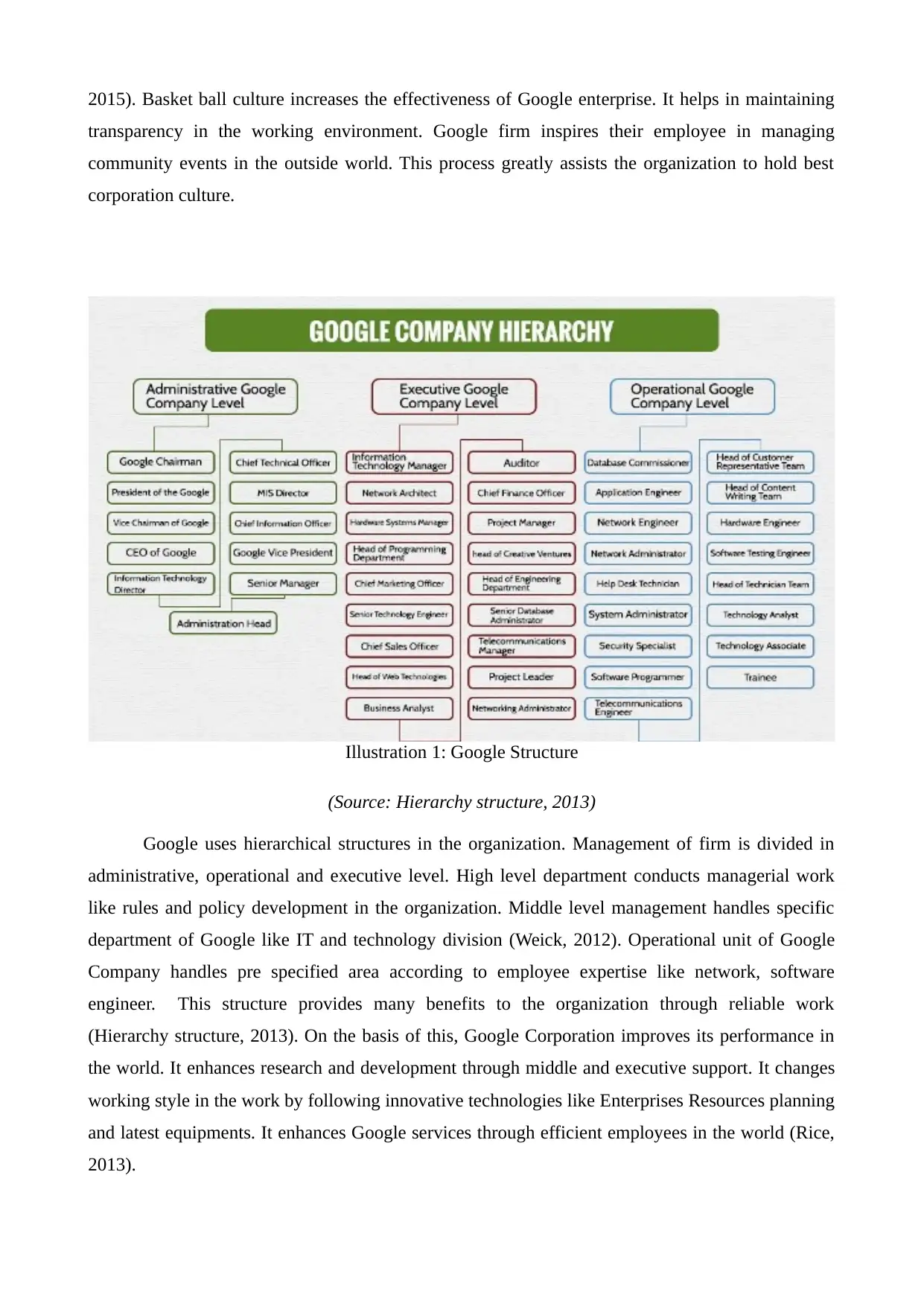
2015). Basket ball culture increases the effectiveness of Google enterprise. It helps in maintaining
transparency in the working environment. Google firm inspires their employee in managing
community events in the outside world. This process greatly assists the organization to hold best
corporation culture.
(Source: Hierarchy structure, 2013)
Google uses hierarchical structures in the organization. Management of firm is divided in
administrative, operational and executive level. High level department conducts managerial work
like rules and policy development in the organization. Middle level management handles specific
department of Google like IT and technology division (Weick, 2012). Operational unit of Google
Company handles pre specified area according to employee expertise like network, software
engineer. This structure provides many benefits to the organization through reliable work
(Hierarchy structure, 2013). On the basis of this, Google Corporation improves its performance in
the world. It enhances research and development through middle and executive support. It changes
working style in the work by following innovative technologies like Enterprises Resources planning
and latest equipments. It enhances Google services through efficient employees in the world (Rice,
2013).
Illustration 1: Google Structure
transparency in the working environment. Google firm inspires their employee in managing
community events in the outside world. This process greatly assists the organization to hold best
corporation culture.
(Source: Hierarchy structure, 2013)
Google uses hierarchical structures in the organization. Management of firm is divided in
administrative, operational and executive level. High level department conducts managerial work
like rules and policy development in the organization. Middle level management handles specific
department of Google like IT and technology division (Weick, 2012). Operational unit of Google
Company handles pre specified area according to employee expertise like network, software
engineer. This structure provides many benefits to the organization through reliable work
(Hierarchy structure, 2013). On the basis of this, Google Corporation improves its performance in
the world. It enhances research and development through middle and executive support. It changes
working style in the work by following innovative technologies like Enterprises Resources planning
and latest equipments. It enhances Google services through efficient employees in the world (Rice,
2013).
Illustration 1: Google Structure
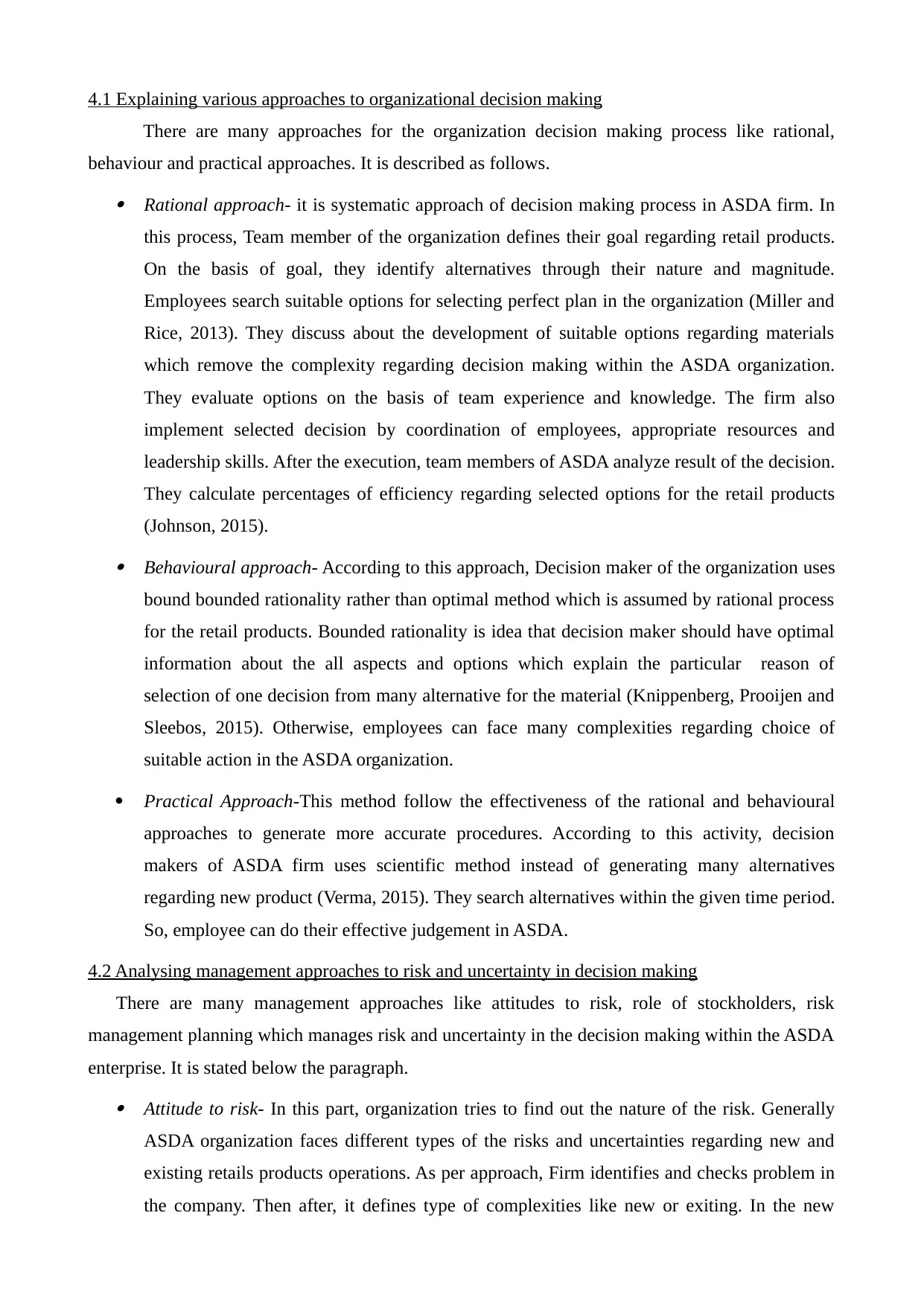
4.1 Explaining various approaches to organizational decision making
There are many approaches for the organization decision making process like rational,
behaviour and practical approaches. It is described as follows.
Rational approach- it is systematic approach of decision making process in ASDA firm. In
this process, Team member of the organization defines their goal regarding retail products.
On the basis of goal, they identify alternatives through their nature and magnitude.
Employees search suitable options for selecting perfect plan in the organization (Miller and
Rice, 2013). They discuss about the development of suitable options regarding materials
which remove the complexity regarding decision making within the ASDA organization.
They evaluate options on the basis of team experience and knowledge. The firm also
implement selected decision by coordination of employees, appropriate resources and
leadership skills. After the execution, team members of ASDA analyze result of the decision.
They calculate percentages of efficiency regarding selected options for the retail products
(Johnson, 2015).
Behavioural approach- According to this approach, Decision maker of the organization uses
bound bounded rationality rather than optimal method which is assumed by rational process
for the retail products. Bounded rationality is idea that decision maker should have optimal
information about the all aspects and options which explain the particular reason of
selection of one decision from many alternative for the material (Knippenberg, Prooijen and
Sleebos, 2015). Otherwise, employees can face many complexities regarding choice of
suitable action in the ASDA organization.
Practical Approach-This method follow the effectiveness of the rational and behavioural
approaches to generate more accurate procedures. According to this activity, decision
makers of ASDA firm uses scientific method instead of generating many alternatives
regarding new product (Verma, 2015). They search alternatives within the given time period.
So, employee can do their effective judgement in ASDA.
4.2 Analysing management approaches to risk and uncertainty in decision making
There are many management approaches like attitudes to risk, role of stockholders, risk
management planning which manages risk and uncertainty in the decision making within the ASDA
enterprise. It is stated below the paragraph.
Attitude to risk- In this part, organization tries to find out the nature of the risk. Generally
ASDA organization faces different types of the risks and uncertainties regarding new and
existing retails products operations. As per approach, Firm identifies and checks problem in
the company. Then after, it defines type of complexities like new or exiting. In the new
There are many approaches for the organization decision making process like rational,
behaviour and practical approaches. It is described as follows.
Rational approach- it is systematic approach of decision making process in ASDA firm. In
this process, Team member of the organization defines their goal regarding retail products.
On the basis of goal, they identify alternatives through their nature and magnitude.
Employees search suitable options for selecting perfect plan in the organization (Miller and
Rice, 2013). They discuss about the development of suitable options regarding materials
which remove the complexity regarding decision making within the ASDA organization.
They evaluate options on the basis of team experience and knowledge. The firm also
implement selected decision by coordination of employees, appropriate resources and
leadership skills. After the execution, team members of ASDA analyze result of the decision.
They calculate percentages of efficiency regarding selected options for the retail products
(Johnson, 2015).
Behavioural approach- According to this approach, Decision maker of the organization uses
bound bounded rationality rather than optimal method which is assumed by rational process
for the retail products. Bounded rationality is idea that decision maker should have optimal
information about the all aspects and options which explain the particular reason of
selection of one decision from many alternative for the material (Knippenberg, Prooijen and
Sleebos, 2015). Otherwise, employees can face many complexities regarding choice of
suitable action in the ASDA organization.
Practical Approach-This method follow the effectiveness of the rational and behavioural
approaches to generate more accurate procedures. According to this activity, decision
makers of ASDA firm uses scientific method instead of generating many alternatives
regarding new product (Verma, 2015). They search alternatives within the given time period.
So, employee can do their effective judgement in ASDA.
4.2 Analysing management approaches to risk and uncertainty in decision making
There are many management approaches like attitudes to risk, role of stockholders, risk
management planning which manages risk and uncertainty in the decision making within the ASDA
enterprise. It is stated below the paragraph.
Attitude to risk- In this part, organization tries to find out the nature of the risk. Generally
ASDA organization faces different types of the risks and uncertainties regarding new and
existing retails products operations. As per approach, Firm identifies and checks problem in
the company. Then after, it defines type of complexities like new or exiting. In the new
⊘ This is a preview!⊘
Do you want full access?
Subscribe today to unlock all pages.

Trusted by 1+ million students worldwide

difficulty case, firm gives very highest priority and severity in the ASDA enterprise because
this thing affects retail operations of company. Management of organization provide full
resources to solve this problem. Second of type of risk and uncertainty is exiting problem
(Bansal, 2011). It means organization has faced this type of complexities before. This type
of risks and uncertainties gets high priority and severity due to affecting the working retail
operation of the ASDA Company. So this way organization defines the nature of the risk and
uncertainty to solve the problem.
Risk Management and Planning- Generally, organization makes different division for the
risk management planning. These divisions monitor activities of the overall firm to identify
the risk and uncertainty in the retail operation of ASDA Corporation. These division try to
find financial, operational, technological and human resources risks in the organization
(Nargesi and et.al., 2013). They try to discover optimistic solution for the enterprise to
neutralise the effect of risk and uncertainty. This way organization can maintain their
performance and productivity.
Role of stakeholders- Generally stakeholders play important role in the ASDA Company to
reduce the impact of risk and uncertainty. Customers provide feedback regarding retails
product which help organization to find out the potential complexities in the market.
Employees and manager of the ASDA Company give their effective ideas and solution in
decision making process regarding new and existing retail products (Ruzaman and Sakka,
2015). Generally corporation manages good communication and relationship with the
suppliers by providing timely payment according to term and conditions. This process
greatly reduces the risk and uncertainty of the ASDA organization.
4.3 Describing the effectiveness of organizational decisions in an organization
There are many effectiveness of ASDA organization regarding decision making. It is
represented below in the paragraph.
According to Piaget (2013), organizational decision is taken on the basis of the scientifically
achieved information in the firm. These things reduces possibilities of errors, risk, uncertainty and
assumptions in the ASDA. It also decreases chances of failure in the project operation on basis of
the logical information and knowledge within the firm. This type of decision helps the employees of
enterprise to work in adverse conditions. However, it is very time consuming process for the
enterprise and it take lot of time to select on decision (Piaget, 2013). It is taken through well-
defined process like step by step process. It breaks down situations into many parts in the ASDA
organization. On the other side, it creates complexities to understand critical situations in the
company. These organizational decisions enhances productivity and efficiency of the enterprise in
this thing affects retail operations of company. Management of organization provide full
resources to solve this problem. Second of type of risk and uncertainty is exiting problem
(Bansal, 2011). It means organization has faced this type of complexities before. This type
of risks and uncertainties gets high priority and severity due to affecting the working retail
operation of the ASDA Company. So this way organization defines the nature of the risk and
uncertainty to solve the problem.
Risk Management and Planning- Generally, organization makes different division for the
risk management planning. These divisions monitor activities of the overall firm to identify
the risk and uncertainty in the retail operation of ASDA Corporation. These division try to
find financial, operational, technological and human resources risks in the organization
(Nargesi and et.al., 2013). They try to discover optimistic solution for the enterprise to
neutralise the effect of risk and uncertainty. This way organization can maintain their
performance and productivity.
Role of stakeholders- Generally stakeholders play important role in the ASDA Company to
reduce the impact of risk and uncertainty. Customers provide feedback regarding retails
product which help organization to find out the potential complexities in the market.
Employees and manager of the ASDA Company give their effective ideas and solution in
decision making process regarding new and existing retail products (Ruzaman and Sakka,
2015). Generally corporation manages good communication and relationship with the
suppliers by providing timely payment according to term and conditions. This process
greatly reduces the risk and uncertainty of the ASDA organization.
4.3 Describing the effectiveness of organizational decisions in an organization
There are many effectiveness of ASDA organization regarding decision making. It is
represented below in the paragraph.
According to Piaget (2013), organizational decision is taken on the basis of the scientifically
achieved information in the firm. These things reduces possibilities of errors, risk, uncertainty and
assumptions in the ASDA. It also decreases chances of failure in the project operation on basis of
the logical information and knowledge within the firm. This type of decision helps the employees of
enterprise to work in adverse conditions. However, it is very time consuming process for the
enterprise and it take lot of time to select on decision (Piaget, 2013). It is taken through well-
defined process like step by step process. It breaks down situations into many parts in the ASDA
organization. On the other side, it creates complexities to understand critical situations in the
company. These organizational decisions enhances productivity and efficiency of the enterprise in
Paraphrase This Document
Need a fresh take? Get an instant paraphrase of this document with our AI Paraphraser
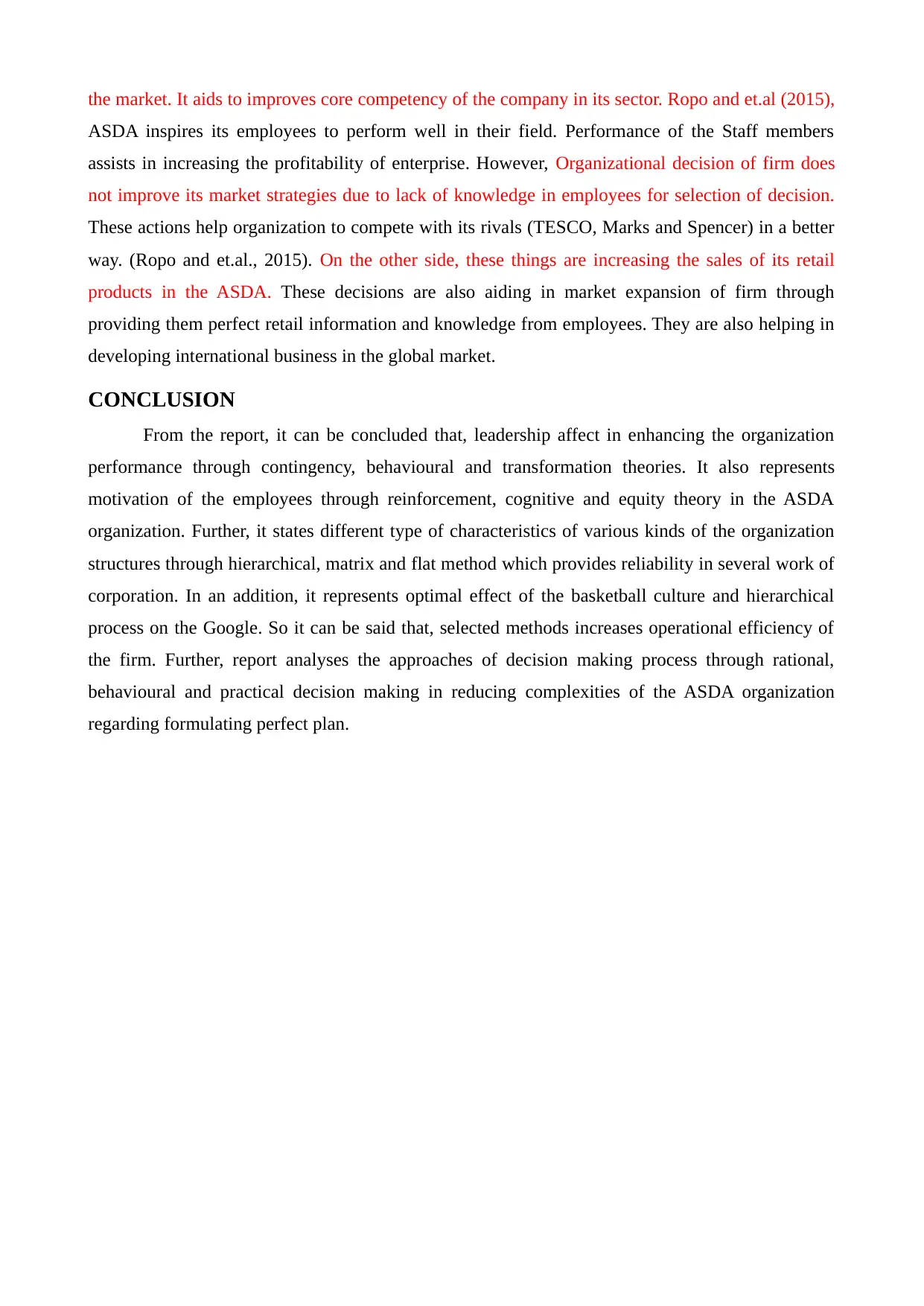
the market. It aids to improves core competency of the company in its sector. Ropo and et.al (2015),
ASDA inspires its employees to perform well in their field. Performance of the Staff members
assists in increasing the profitability of enterprise. However, Organizational decision of firm does
not improve its market strategies due to lack of knowledge in employees for selection of decision.
These actions help organization to compete with its rivals (TESCO, Marks and Spencer) in a better
way. (Ropo and et.al., 2015). On the other side, these things are increasing the sales of its retail
products in the ASDA. These decisions are also aiding in market expansion of firm through
providing them perfect retail information and knowledge from employees. They are also helping in
developing international business in the global market.
CONCLUSION
From the report, it can be concluded that, leadership affect in enhancing the organization
performance through contingency, behavioural and transformation theories. It also represents
motivation of the employees through reinforcement, cognitive and equity theory in the ASDA
organization. Further, it states different type of characteristics of various kinds of the organization
structures through hierarchical, matrix and flat method which provides reliability in several work of
corporation. In an addition, it represents optimal effect of the basketball culture and hierarchical
process on the Google. So it can be said that, selected methods increases operational efficiency of
the firm. Further, report analyses the approaches of decision making process through rational,
behavioural and practical decision making in reducing complexities of the ASDA organization
regarding formulating perfect plan.
ASDA inspires its employees to perform well in their field. Performance of the Staff members
assists in increasing the profitability of enterprise. However, Organizational decision of firm does
not improve its market strategies due to lack of knowledge in employees for selection of decision.
These actions help organization to compete with its rivals (TESCO, Marks and Spencer) in a better
way. (Ropo and et.al., 2015). On the other side, these things are increasing the sales of its retail
products in the ASDA. These decisions are also aiding in market expansion of firm through
providing them perfect retail information and knowledge from employees. They are also helping in
developing international business in the global market.
CONCLUSION
From the report, it can be concluded that, leadership affect in enhancing the organization
performance through contingency, behavioural and transformation theories. It also represents
motivation of the employees through reinforcement, cognitive and equity theory in the ASDA
organization. Further, it states different type of characteristics of various kinds of the organization
structures through hierarchical, matrix and flat method which provides reliability in several work of
corporation. In an addition, it represents optimal effect of the basketball culture and hierarchical
process on the Google. So it can be said that, selected methods increases operational efficiency of
the firm. Further, report analyses the approaches of decision making process through rational,
behavioural and practical decision making in reducing complexities of the ASDA organization
regarding formulating perfect plan.
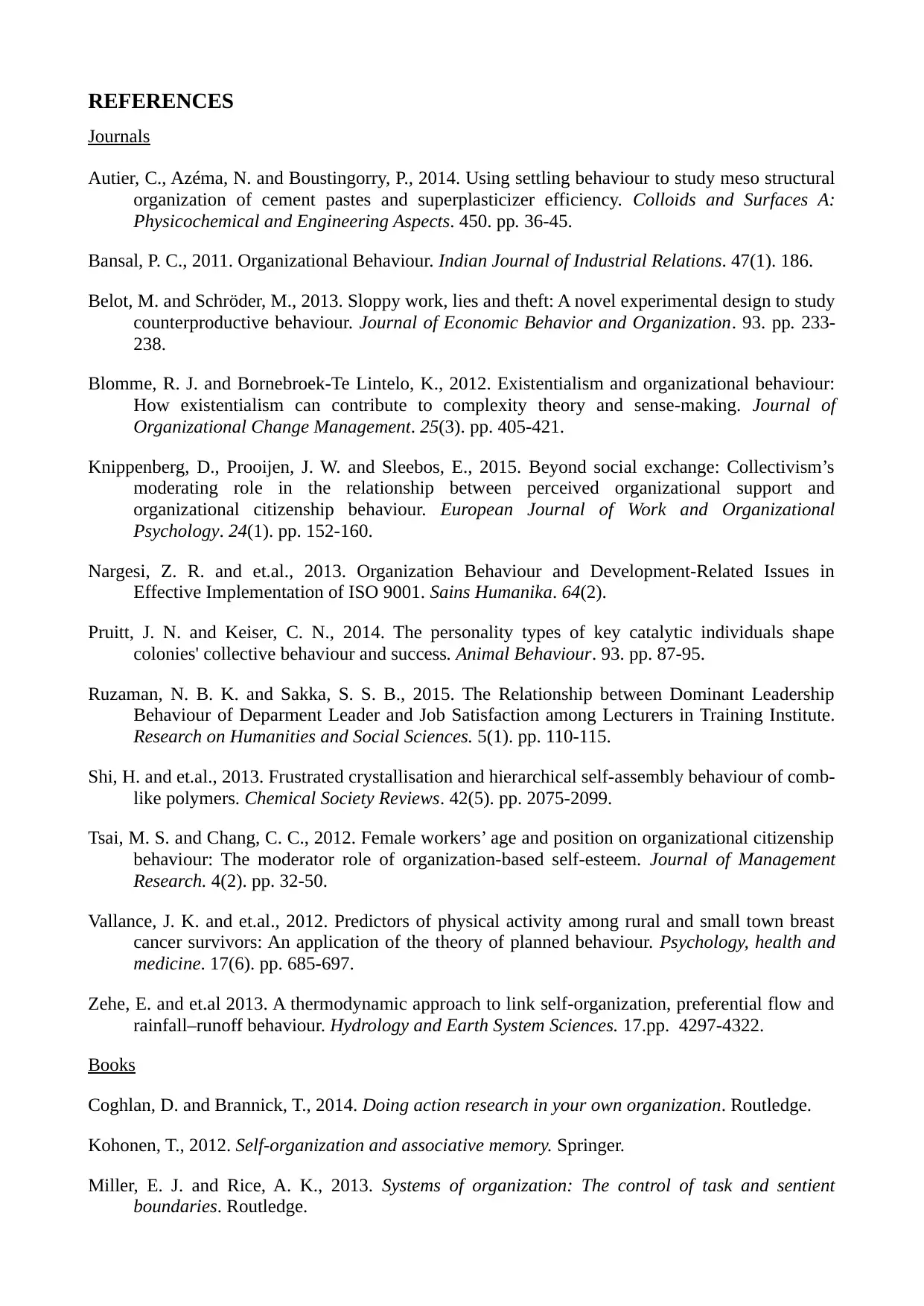
REFERENCES
Journals
Autier, C., Azéma, N. and Boustingorry, P., 2014. Using settling behaviour to study meso structural
organization of cement pastes and superplasticizer efficiency. Colloids and Surfaces A:
Physicochemical and Engineering Aspects. 450. pp. 36-45.
Bansal, P. C., 2011. Organizational Behaviour. Indian Journal of Industrial Relations. 47(1). 186.
Belot, M. and Schröder, M., 2013. Sloppy work, lies and theft: A novel experimental design to study
counterproductive behaviour. Journal of Economic Behavior and Organization. 93. pp. 233-
238.
Blomme, R. J. and Bornebroek-Te Lintelo, K., 2012. Existentialism and organizational behaviour:
How existentialism can contribute to complexity theory and sense-making. Journal of
Organizational Change Management. 25(3). pp. 405-421.
Knippenberg, D., Prooijen, J. W. and Sleebos, E., 2015. Beyond social exchange: Collectivism’s
moderating role in the relationship between perceived organizational support and
organizational citizenship behaviour. European Journal of Work and Organizational
Psychology. 24(1). pp. 152-160.
Nargesi, Z. R. and et.al., 2013. Organization Behaviour and Development-Related Issues in
Effective Implementation of ISO 9001. Sains Humanika. 64(2).
Pruitt, J. N. and Keiser, C. N., 2014. The personality types of key catalytic individuals shape
colonies' collective behaviour and success. Animal Behaviour. 93. pp. 87-95.
Ruzaman, N. B. K. and Sakka, S. S. B., 2015. The Relationship between Dominant Leadership
Behaviour of Deparment Leader and Job Satisfaction among Lecturers in Training Institute.
Research on Humanities and Social Sciences. 5(1). pp. 110-115.
Shi, H. and et.al., 2013. Frustrated crystallisation and hierarchical self-assembly behaviour of comb-
like polymers. Chemical Society Reviews. 42(5). pp. 2075-2099.
Tsai, M. S. and Chang, C. C., 2012. Female workers’ age and position on organizational citizenship
behaviour: The moderator role of organization-based self-esteem. Journal of Management
Research. 4(2). pp. 32-50.
Vallance, J. K. and et.al., 2012. Predictors of physical activity among rural and small town breast
cancer survivors: An application of the theory of planned behaviour. Psychology, health and
medicine. 17(6). pp. 685-697.
Zehe, E. and et.al 2013. A thermodynamic approach to link self-organization, preferential flow and
rainfall–runoff behaviour. Hydrology and Earth System Sciences. 17.pp. 4297-4322.
Books
Coghlan, D. and Brannick, T., 2014. Doing action research in your own organization. Routledge.
Kohonen, T., 2012. Self-organization and associative memory. Springer.
Miller, E. J. and Rice, A. K., 2013. Systems of organization: The control of task and sentient
boundaries. Routledge.
Journals
Autier, C., Azéma, N. and Boustingorry, P., 2014. Using settling behaviour to study meso structural
organization of cement pastes and superplasticizer efficiency. Colloids and Surfaces A:
Physicochemical and Engineering Aspects. 450. pp. 36-45.
Bansal, P. C., 2011. Organizational Behaviour. Indian Journal of Industrial Relations. 47(1). 186.
Belot, M. and Schröder, M., 2013. Sloppy work, lies and theft: A novel experimental design to study
counterproductive behaviour. Journal of Economic Behavior and Organization. 93. pp. 233-
238.
Blomme, R. J. and Bornebroek-Te Lintelo, K., 2012. Existentialism and organizational behaviour:
How existentialism can contribute to complexity theory and sense-making. Journal of
Organizational Change Management. 25(3). pp. 405-421.
Knippenberg, D., Prooijen, J. W. and Sleebos, E., 2015. Beyond social exchange: Collectivism’s
moderating role in the relationship between perceived organizational support and
organizational citizenship behaviour. European Journal of Work and Organizational
Psychology. 24(1). pp. 152-160.
Nargesi, Z. R. and et.al., 2013. Organization Behaviour and Development-Related Issues in
Effective Implementation of ISO 9001. Sains Humanika. 64(2).
Pruitt, J. N. and Keiser, C. N., 2014. The personality types of key catalytic individuals shape
colonies' collective behaviour and success. Animal Behaviour. 93. pp. 87-95.
Ruzaman, N. B. K. and Sakka, S. S. B., 2015. The Relationship between Dominant Leadership
Behaviour of Deparment Leader and Job Satisfaction among Lecturers in Training Institute.
Research on Humanities and Social Sciences. 5(1). pp. 110-115.
Shi, H. and et.al., 2013. Frustrated crystallisation and hierarchical self-assembly behaviour of comb-
like polymers. Chemical Society Reviews. 42(5). pp. 2075-2099.
Tsai, M. S. and Chang, C. C., 2012. Female workers’ age and position on organizational citizenship
behaviour: The moderator role of organization-based self-esteem. Journal of Management
Research. 4(2). pp. 32-50.
Vallance, J. K. and et.al., 2012. Predictors of physical activity among rural and small town breast
cancer survivors: An application of the theory of planned behaviour. Psychology, health and
medicine. 17(6). pp. 685-697.
Zehe, E. and et.al 2013. A thermodynamic approach to link self-organization, preferential flow and
rainfall–runoff behaviour. Hydrology and Earth System Sciences. 17.pp. 4297-4322.
Books
Coghlan, D. and Brannick, T., 2014. Doing action research in your own organization. Routledge.
Kohonen, T., 2012. Self-organization and associative memory. Springer.
Miller, E. J. and Rice, A. K., 2013. Systems of organization: The control of task and sentient
boundaries. Routledge.
⊘ This is a preview!⊘
Do you want full access?
Subscribe today to unlock all pages.

Trusted by 1+ million students worldwide
1 out of 13
Related Documents
Your All-in-One AI-Powered Toolkit for Academic Success.
+13062052269
info@desklib.com
Available 24*7 on WhatsApp / Email
![[object Object]](/_next/static/media/star-bottom.7253800d.svg)
Unlock your academic potential
Copyright © 2020–2025 A2Z Services. All Rights Reserved. Developed and managed by ZUCOL.





